WASHINGTON - The Republicans' presidential primary slugfest has all of our attention right now, but the general election race is really the more interesting story.
The toxic contest between former governor Mitt Romney and former House speaker Newt Gingrich for their party's nomination probably still has a long way to go before it is over. But the head-to-head race to deny Barack Obama a second term is already well underway.
Surprisingly consistent voter preferences have been pouring in for months now, and the latest returns show the president is struggling against one of the top Republican candidates.
These preferences are the polling numbers in the head-to-head match-ups between Obama and the Republican contenders, and what they show will most likely determine who the GOP's standard-bearer will be this fall.
Last week, the Gallup Poll surveyed registered voters in 12 key swing states that will probably decide who wins in November. That poll showed voters were "almost evenly split between Barack Obama and Mitt Romney."
These swing states included Colorado, Florida, Iowa, Michigan, Nevada, New Hampshire, New Mexico, North Carolina, Ohio, Pennsylvania, Virginia and Wisconsin.
Actually, Romney beats Obama in these swing states by 48 percent to 47 percent, edging out the president by one point.
Among registered voters nationally, Romney and Obama are in a dead heat 48 percent to 48 percent.
But Romney's stronger showing among the swing states -- where the jobless rate is about 10 percent to 13 percent in several of them -- trumps the national numbers because half a dozen of these swing states are among the biggest electoral prizes that will pick the winner.
Recommended
Gingrich, the weakest of Romney's rivals in the match-ups, does poorly against Obama in the key swing states, trailing the president by 14 points, 54 percent to 40 percent. He trails Obama by 12 points nationally.
Rep. Ron Paul loses to Obama by 43 percent to 50 percent, while former Sen. Rick Santorum does a teeny bit better, losing by 44 percent to 51 percent.
Gallup has been conducting the head-to-head polls in these swing states since last October, late November/early December, and more recently between Jan. 24-28.
Despite the ups and downs of the GOP primary battle throughout this four month period, "Obama and Romney have been closely matched in each of the three swing-states polls," Gallup said. They've "also been statistically tied in each of five polls conducted among national registered voters dating back to August."
"Thus, even as the Republicans' support for various candidates has fluctuated substantially, the preferences of all registered voters for Obama or Romney nationally and in the swing states have remained quite stable," the polling firm said.
As for Gingrich's earlier lead over Romney among all Republican voters, Gallup's surveys now show the former Georgia congressman's strength in both swing states and nationally "has deteriorated" since late November and early December.
Gallup said Monday that its "daily tracking of national Republican preferences for their party's nominee over the weekend shows Gingrich's lead over Romney slipping, with the two nearly back to a tie."
What all of this shows is that Obama remains a weak incumbent who hasn't been able to break out of his bleak job approval polls that are stuck in the mid-40s.
The reason why is the economy remains weak. It grew by an anemic 2.8 percent in the fourth quarter, while the national unemployment rate is stuck in the near-9 percent range, and forecasters say that is unlikely to improve anytime soon.
Obama's State of the Union address last week didn't do much to change the economic scores of his presidency. It was a pasty stew of higher spending for more public works projects, taxes on investments and small businesses and billions of dollars in special interest expenditures aimed at the voters he needs to win a second term.
As he enters the fourth year of his presidency, Obama clings to a rise in last month's jobs numbers that he says is proof the economy is improving.
But unemployment fell in December in large measure because so many discouraged workers stopped looking for a job and dropped out of the workforce. Even some of Obama's defenders are not impressed by the 200,000 jobs gained, calling it a statistical anomaly and predicting that unemployment will rise again this year in the midst of the election.
"I expect the unemployment rate to edge upwards in the next few months.... My bet is that we are still over 8 percent next December," liberal economist Dean Baker, co-director of the Center for Economic and Policy Research, told the Washington Post last month. "I think [the decline in the jobless rate] is mostly a statistical fluke," Baker said.
So does the nonpartisan Congressional Budget Office who projected Tuesday that the jobless rate would climb to 8.9 percent by the end of this year and rise to 9.2 percent next year.
The economy grew at a snail's pace 1.7 percent last year, a feeble rate that the Post's economics writer Peter Whoriskey called "a dismal result after many forecasts of robust growth made at the beginning of the year."
The fourth quarter's disappointing 2.8 percent growth rate -- well below bullish forecasts -- was further proof of the continuing economic impotence of the administration's policies.
"To put that in perspective, over the last 60 years, the average historical growth rate for the U.S. economy has been about 3.2 percent," Whoriskey writes.
No one expects this economy to take off this year or even next under Obama's direction. The Federal Reserve Board said as much last week.
Polls now showing the president tied with Romney may be the high point in Obama's last year in office.

























Join the conversation as a VIP Member